2023Activity reportProject-TeamMEMPHIS
RNSR: 201521153G- Research center Inria Centre at the University of Bordeaux
- In partnership with:Université de Bordeaux
- Team name: Modeling Enablers for Multi-PHysics and InteractionS
- In collaboration with:Institut de Mathématiques de Bordeaux (IMB)
- Domain:Applied Mathematics, Computation and Simulation
- Theme:Numerical schemes and simulations
Keywords
Computer Science and Digital Science
- A6. Modeling, simulation and control
- A6.1.1. Continuous Modeling (PDE, ODE)
- A6.1.5. Multiphysics modeling
- A6.2.1. Numerical analysis of PDE and ODE
- A6.3.1. Inverse problems
- A6.3.2. Data assimilation
- A6.3.4. Model reduction
- A6.5.1. Solid mechanics
- A6.5.2. Fluid mechanics
- A9.2. Machine learning
Other Research Topics and Application Domains
- B2.2.1. Cardiovascular and respiratory diseases
- B4.2. Nuclear Energy Production
- B4.3.2. Hydro-energy
- B4.3.3. Wind energy
- B5.2.3. Aviation
- B5.2.4. Aerospace
- B5.5. Materials
1 Team members, visitors, external collaborators
Research Scientists
- Michel Bergmann [INRIA, Researcher, until Sep 2023, HDR]
- Michel Bergmann [INRIA, Senior Researcher, from Oct 2023, HDR]
- Michele Giuliano Carlino [ONERA, from Sep 2023]
- Alessia Del Grosso [INRIA, ISFP, from Nov 2023]
- Tommaso Taddei [INRIA, Researcher]
Faculty Members
- Angelo Iollo [Team leader, UNIV BORDEAUX, Professor, HDR]
- Afaf Bouharguane [UNIV BORDEAUX, Associate Professor]
Post-Doctoral Fellows
- Umberto Bosi [INRIA, Post-Doctoral Fellow]
- Antoine Fondaneche [INRIA, until Sep 2023]
- Birgul Koc [IFPEN, until Nov 2023]
- Nishant Kumar [INRIA]
PhD Students
- Eki Agouzal [EDF]
- Beatrice Battisti [ECOLE POLYT. TURIN, from May 2023]
- Maxime Chapron [ONERA]
- Jon Labatut [ONERA]
- Caroline Anna-Lise Andrea Le Guern [IFPEN]
- Karl Maroun [UNIV POITIERS]
- Abdessamad Moussaddak [EDF, CIFRE, from Dec 2023]
- Thomas Philibert [ECOLE POLYT. TURIN]
- Michele Romanelli [ONERA]
- Ludovica Saccaro [INRIA, from Nov 2023]
- Alexis Tardieu [UNIV BORDEAUX]
- Mathias Truel [INGELIANCE, CIFRE, from May 2023]
Interns and Apprentices
- Mohamed Ben Abdelouahab [INRIA, from Feb 2023 until Jul 2023]
- Emanuela Dotti [INRIA, Intern, from Oct 2023]
- Elian Richard [INRIA, from Jun 2023 until Sep 2023]
- Pablo Solan Fustero [UNIV SARAGOSSE, from Mar 2023 until May 2023]
Administrative Assistant
- Anne-Laure Gautier [INRIA, from Oct 2023]
Visiting Scientist
- Michele Giuliano Carlino [UNIV FERRARA, from Feb 2023 until Sep 2023]
External Collaborators
- Majdi Azaiez [Bordeaux INP, HDR]
- Astrid Decoene [UNIV BORDEAUX, from Dec 2023]
- Philippe Depouilly [CNRS, from Mar 2023]
- Francesco Fabbri [GSSI, from Oct 2023]
2 Overall objectives
2.1 Multi-physics numerical modeling
2.1.1 Reduced-order models: convergence between PDE models and data
Unprecedented opportunities exist to directly use already collected computational or experimental data to improve and build predictive models that can be used online for the simulation of parametric problems, robust design, and control in science and engineering. In this regard, our goal is to combine mechanistic causal models based on partial differential equations (PDEs) with large data sets to reduce the marginal cost of predictions.
Reduced-order models (ROMs) are our main tool for this purpose. ROMs are parametric mathematical models derived from the full set of PDEs using previously computed solutions. In many applications, the solution space turns out to be low-dimensional, so one can trade a minimal loss of accuracy for speed and scalability. ROMs counteract the curse of dimensionality by significantly reducing computational complexity.
Overall, ROMs have reached a certain level of maturity during the last decade, allowing their implementation in large-scale industrial codes, mainly in structural mechanics. Nevertheless, some hard points stand. Parametric problems governed by strong advection fields or sensibly compact-support solutions such as moving shocks suffer from a limited possibility of dimensional reduction and, at the same time, insufficient generalization of the model (out-of-sample solutions). The main reason for this is that the solution space is usually approximated by an affine or linear representation, which is intrinsically broad band for such problems.
We have worked on the development of model order reduction (MOR) techniques for nonlinear, advection-dominated problems, with emphasis on projection-based Galerkin and Petrov-Galerkin ROMs. First, we worked on the development of effective sampling strategies to reduce training costs. Second, we developed nonlinear, registration-based approximation techniques, to overcome limitations of linear approximation methods (e.g., proper orthogonal decomposition, POD) to deal with strong advection fields. Third, we developed hybrid formulations that combine reduced-order and full-order models to deal with complex flow features and/or complex parameterizations.
2.1.2 Schemes for Hierarchical meshes, multi-physics and asymptotic limits
The schemes we have developed aim at simulating complex multiphysics phenomena through appropriate PDE modeling, automatic implicit geometry representation (level sets), hierarchical Cartesian schemes (quad-octrees), parallel simulations, and accurate treatment of boundaries. Discretization schemes on hierarchical meshes allow multiscale solution of PDEs on non-body-fitted meshes with a drastic reduction in computational setup overhead. The key idea is to use an octree mesh to approximate the solution fields, while the geometry is captured by level set functions. The boundary conditions are determined by appropriate interpolation methods to achieve sufficient accuracy. This approach eliminates the need for boundary conforming meshes, which require time-consuming and error-prone mesh generation procedures, and opens the door to easy parallel simulation of very complex geometries.
One of the limitations of this approach is that a mesh with a fixed aspect ratio is not optimal for very anisotropic fields such as boundary layers. For such cases, we explored the idea of using a body-fitted grid near the immersed obstacles and a hierarchical mesh in the background. Essentially, we use the techniques we have developed to impose boundary conditions on non-body-matched meshes further from the boundary, where the solution is smoother and more isotropic. Our current investigations build on discontinuous Galerkin (DG) methods / ADER approaches to combine efficient interpolation strategies at the grid interfaces and compact reconstruction of the data at the grid level.
Part of our activity has been dedicated to improve schemes for all Mach number flows in both fluid dynamics and continuum mechanics. Phenomena of interest involve fluid flows and elastic materials whose deformations are investigated within a monolithic Eulerian framework. With this approach any material (gas, liquid or solid) can be described with the same system of conservation equations and a suitable general formulation of the constitutive law.
These schemes are accurate in computing steady state solutions as well as in approximating material wave propagation in various Mach regimes and different materials. We studied methods to overcome the need to solve for auxiliary relaxation variables while preserving the properties of the linearly implicit schemes. To achieve this, we split the stiff relaxation source terms from the fluxes and then reformulate the homogeneous part in an elliptic form. Further research on obtaining all Mach methods by including multi-dimensional knowledge in the numerical scheme is also being conducted. More specifically, we envisage to exploit a nodal pressure that depends on all the cells around the given node and naturally encompasses a consistent discretization of the divergence of the velocity vector.
3 Research program
Coherently with our investigation approach, we start from real-world applications to identify key methodological problems, then, we study those problems and develop new methods to address them; finally, we implement these methods for representative test cases to demonstrate their practical relevance.
3.1 Numerical models
We aim to further develop automated model-order reduction (MOR) procedures for large-scale systems in computational mechanics — here, automated refers to the ability to complete the analysis with minimal user intervention. First, we wish to combine nonlinear MOR with mesh adaptation to simultaneously learn rapid and reliable ROMs and effective high-fidelity discretizations over a range of parameters. Second, we wish to develop component-based MOR procedures to build inter-operable components for steady and unsteady nonlinear PDEs: towards this end, we should develop efficient localized training procedures to build local ROMs for each archetype component, and also domain decomposition techniques to glue together the local models for prediction. We also wish to develop and analyze hybrid approaches that combine and merge first-principle models with data-fit models, and also full-order and reduced-order models for prediction of global engineering quantities of interest.
We envision that several methods that are currently developed in the team can be complemented by available tools from machine learning: representative examples include — but are not limited to — solution clustering, optimal sampling, classification. In this respect, a leap forward in industrial applications that we will pursue is without doubts the possibility of capitalizing on previous experience drawn from already acquired simulations to build non-intrusive models that combine non-linear interpolations and non-linear regression. New perspectives in this direction are offered by the Chair Onera-Nouvelle Aquitaine (cf. Regional initiatives).
As regards the work on numerical discretization of PDEs, compared to the previous evaluation, we focus on the representation of the solution in each computational cell by adopting a DG/ADER approach to improve the resolution of solution's discontinuities. This approach is complemented with a Chimera grid at the boundaries in order to improve accuracy by a body fitted mesh avoiding grid generation complexity for a general, possibly varying, geometrical topology. The thesis of Alexis Tardieu, which started in October 2021 and is funded by the University of Bordeaux, studies this approach.
In parallel, we continue our exploration of schemes in asymptotic regimes such as low- and high Mach numbers for multi-material flows. We aim for schemes that circumvent the problem of accuracy and time stepping in such regimes: the ultimate goal is to devise asymptotic-preserving schemes that are able to capture phenomena at the time scale of the fast waves and of the material waves with the same accuracy. For such a purpose, a new path based on numerical schemes with multi-dimensional knowledge is also being explored.
3.2 Applications
For energy applications, we will continue our investigations on wave energy converters and windturbines. Relative to wave energy converters, we are developing multifidelty models that couple the incompressible Navier-Stoke equations (NSE) around the floater with a Proper Orthogonal (POD) ROM or a simplified-physics model elsewhere.
- In October 2021, Nishant Kumar started a two-year postdoctoral fellowship in the team, which was funded by the Inria-IfpEN program; the aim is to couple an high-fidelity model and a POD model based on the LES Navier-Stokes equations; the coupling is implemented in the SOWFA framework of OpenFOAM.
- In December 2021, Caroline Le Guern started her PhD in the team, in the framework of the Inria-IfpEN program; Caroline works on the modeling and simulation of the fluid-structure interaction of next-generation windturbines with up to 250 meter rotor; the numerical implementation is based on the software Deeplines that is co-developed by IfpEN.
- In April 2022, Umberto Bosi started a two-year postdoctoral fellowship in the team, in collaboration with CARDAMOM: the project of Umberto, which was funded by Inria and the Region Nouvelle Aquitaine, focuses on the coupling between an high-fidelity (e.g., Navier-Stokes) model and an asymptotic (e.g., shallow water or Boussinesq) model.
We are also collaborating with EDF to devise effective ROMs for parametric studies. In this collaboration, we emphasize the implementation of projection-based ROMs for real-world applications exploiting industrial codes.
- In April 2021, Eki Agouzal started an industrial thesis to develop projection-based ROMs for nonlinear structural mechanics problems in Code Aster, with emphasis on thermo-hydro-mechanical (THM) applications.
- In December 2023, Abdessamad Moussaddak started his PhD thesis on model reduction for river and coastal hydraulics.
Within the ARIA project, in collaboration with Nurea and the bio-mechanics lab of the Politecnico di Torino, we investigate the idea of data augmentation starting from a given aneurysm database. We construct statistically relevant synthetic aneurysms that can provide both heterogeneity and closeness to reality to test new bio-markers for aneurysm rupture. The thesis of Ludovica Saccaro funded by Inria is dedicated to this subject.
In the framework of the ANR DRAGON, we also increase our interactions with researchers in biology and physical science. in the center of biological studies in Chizé (centre d'études biologiques de Chizé). The ANR funds the PhD thesis of Karl Maroun at University of Poitiers.
The software development will be continued. We will pursue the development of the NEOS library: NEOS will be distributed in open source LGPL-3.0. The HIWIND software will be rewritten based on NEOS library.
4 Application domains
4.1 Energy conversion
We apply the methods developed in our team to the domain of wind engineering and sea-wave converters.
In Figure 1, we show results of a numerical model for a
sea-wave energy converter. We here rely on a monolithic model to describe the
interaction between the rigid floater, air and water; material properties
such as densities, viscosities and rigidity vary across the domain.
The appropriate boundary conditions are imposed at interfaces that arbitrarily cross the grid using adapted schemes built thanks to geometrical information computed via level set functions 44.
The background method for fluid-structure interface is the volume penalization method 32 where the level set functions is used to improve the degree of accuracy of the method
4 and also to follow the object.
The underlined mathematical model is unsteady, and
three dimensional; numerical simulations based on a grid
with
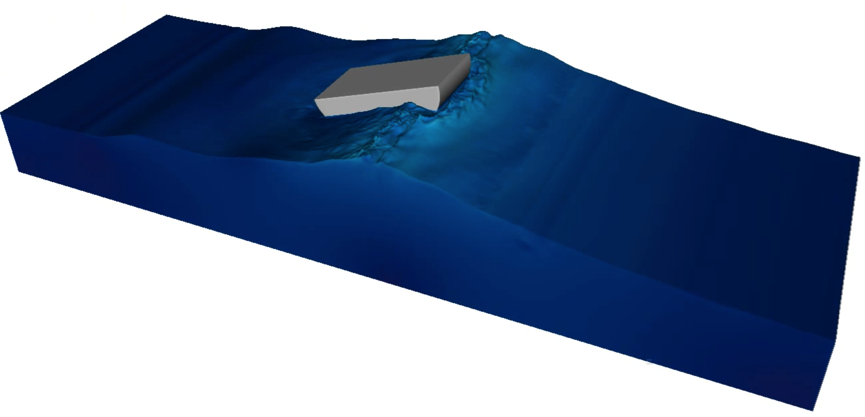
See-wave converter

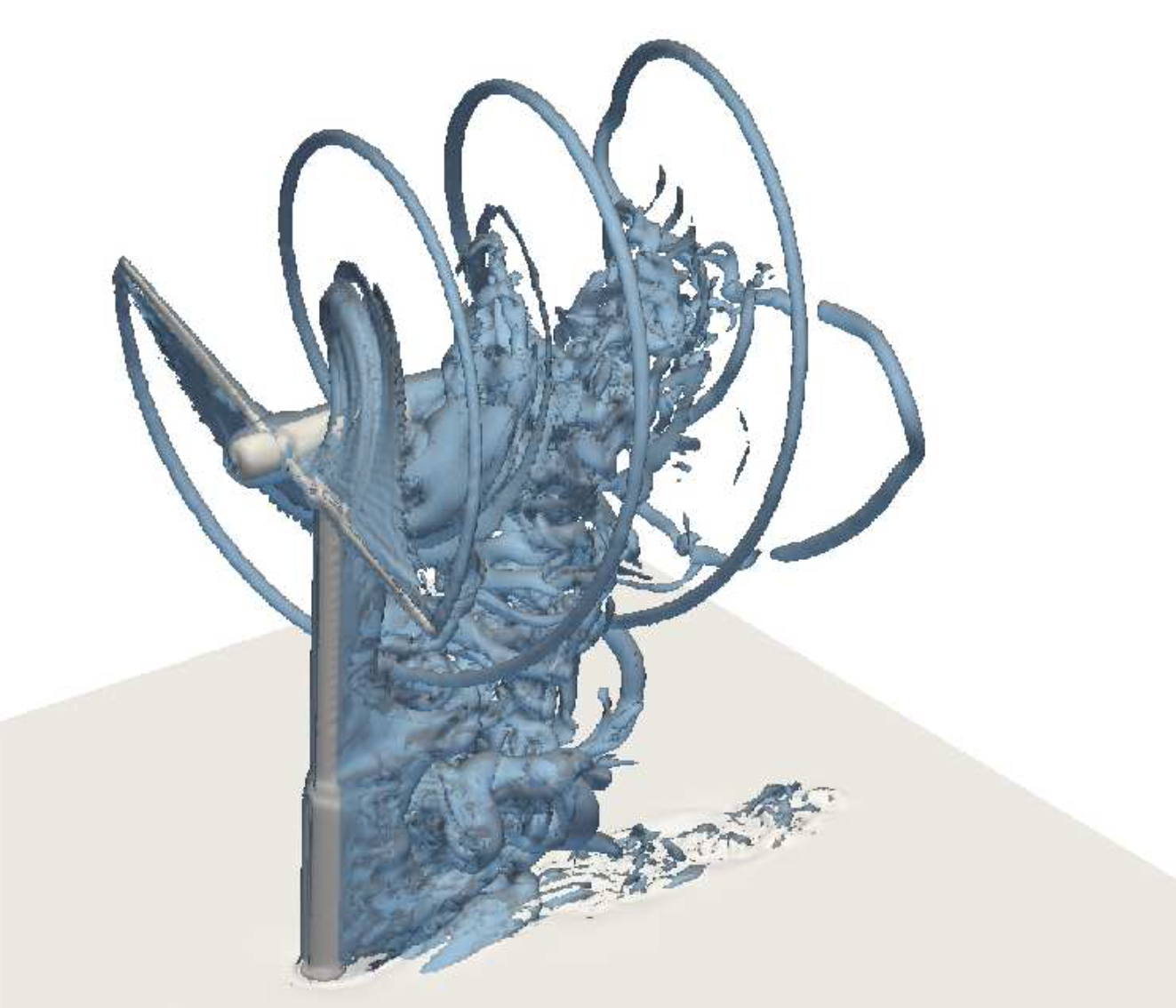
Wind turbine
In the context of the Aerogust (Aeroelastic gust modelling) European project, together with Valorem, we investigated the behavior of wind turbine blades under gust loading. The aim of the project was to optimize the design of wind turbine blades to maximize the power extracted. A meteorological mast (Figure 2(a)) has been installed in March 2017 in Brittany to measure wind on-site: data provided by the mast have been exploited to initialize the mathematical model. Due to the large cost of the full-order mathematical model, we relied on a simplified model 42 to optimize the global twist. Then, we validated the optimal configuration using the full-order Cartesian model based on the NaSCar solver. Figure 2(b) shows the flow around the optimized optimized wind turbine rotor.
4.2 Schemes for turbulent flow simulations using Octrees
We have initially developed and tested a 3D first-order Octree code for unsteady incompressible Navier-Stokes equations for full windmill simulations with an LES model and wall laws. We have validated this code on Occigen for complex flows at increasing Reynolds numbers. This step implied identifying stable and feasible schemes compatible with the parallel linear Octree structure. The validation has been conducted with respect to the results of a fully Cartesian code (NaSCAR) that we run on Turing (with significantly more degrees of freedom) and with respect to experimental results.
Subsequently, we have developed a second-order Octree scheme that has been validated on Occigen for a sphere at a moderate Reynolds number (
| Mesh |
|
number of cells |
|
|
| 1 |
|
|
N.A. |
|
| 2 |
|
|
|
|
| 3 |
|
|
|
|
| 4 |
|
|
|
|
| Case |
|
| Octree, 1st-order scheme |
|
| Octree, 2nd-order scheme |
|
| Cartesian |
|
| Experimental estimate 35 |
|

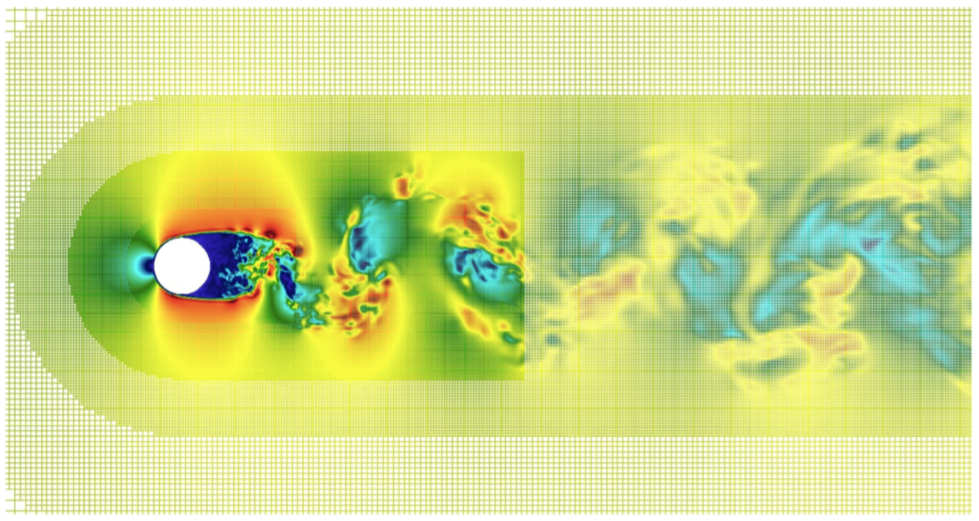
Turbulent simulations
4.3 Vascular flows
A new research direction pursued by the team is the mathematical modelling of vascular blood flows in arteries. Together with the start-up Nurea and the surgeon Eric Ducasse, we aim at developing reliable and automatic procedures for aneurysm segmentation and for the prediction of aneurysm rupture risk. Our approach exploits two sources of information: (i) numerical simulations of blood flows in complex geometries, based on an octree discretization, and (ii) computed tomography angiography (CTA) data. Figure 4 shows the force distribution on the walls of the abdominal aorta in presence of an aneurysm; results are obtained using a parallelized hierarchical Cartesian scheme based on octrees.
Further information is given in the sections dedicated to the new results.
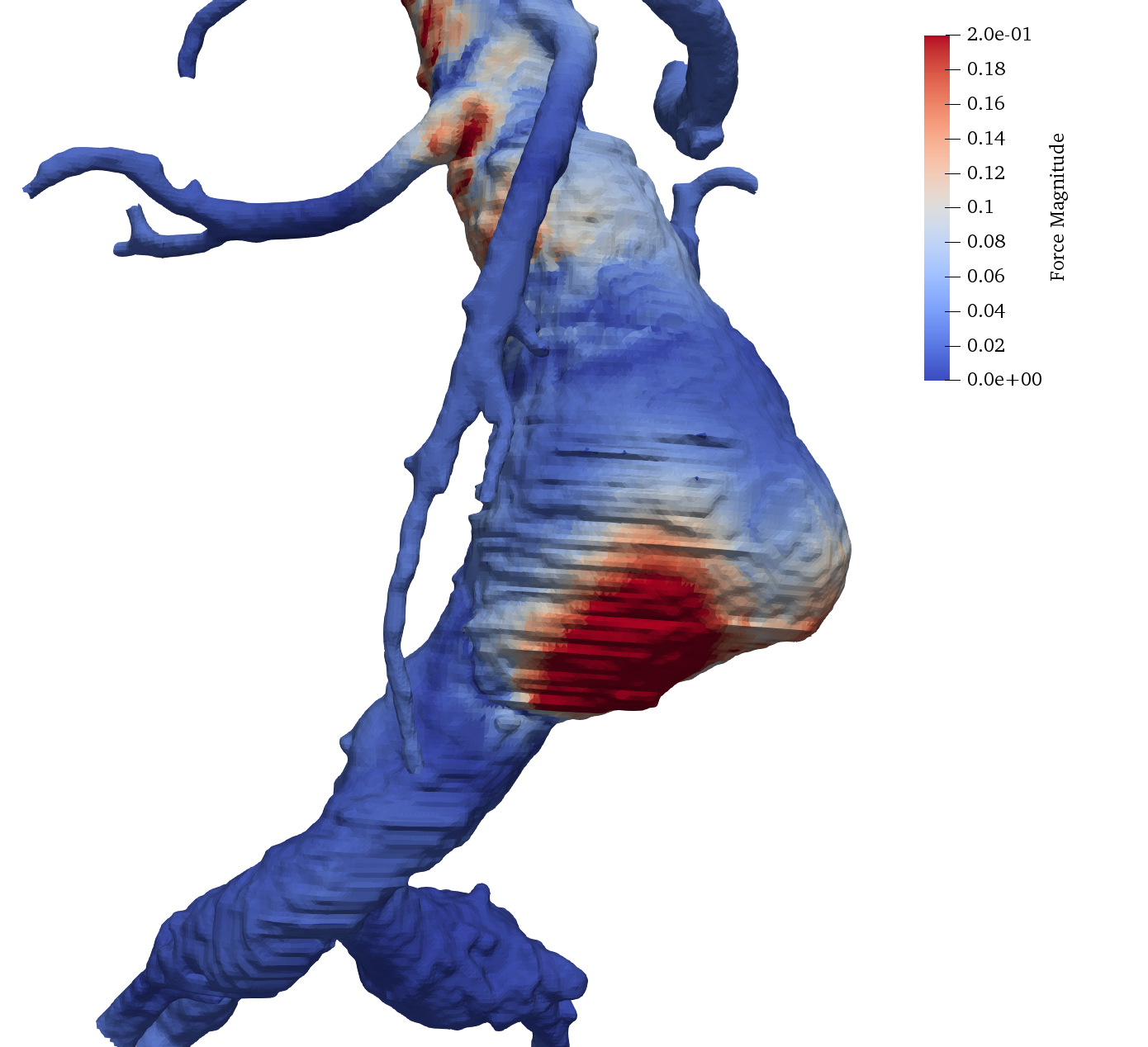
Aneurysm simulation
4.4 Fluid-structure interactions using Eulerian non-linear elasticity models
Mathematical and numerical modeling of continuum systems undergoing extreme regimes is challenging due to the presence of large deformations and displacements of the solid part, and due to the strongly non-linear behavior of the fluid part. At the same time, proper experiments of impact phenomena are particularly dangerous and require expensive facilities, which make them largely impractical. For this reason, there is a growing interest in the development of predictive models for impact phenomena.
In MEMPHIS, we rely on a fully Eulerian approach based on conservation laws, where the different materials are characterized by their specific constitutive laws, to address these tasks. This approach was introduced in 39 and subsequently
pursued and extended in 43, 38, 33, 34 and 9.
In Figure 5, we show the results of the numerical simulation of the impact of a copper projectile immersed in air over a copper shield.
Results are obtained using a fully parallel monolithic Cartesian method, based on
a
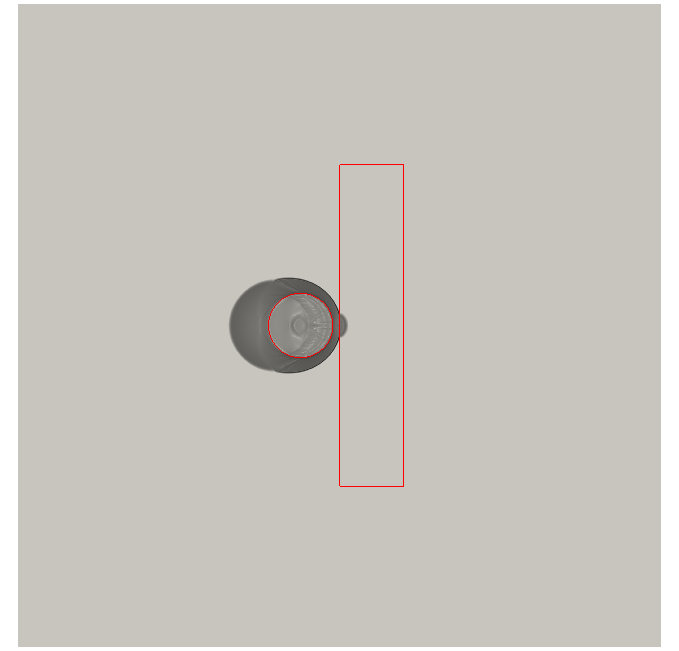
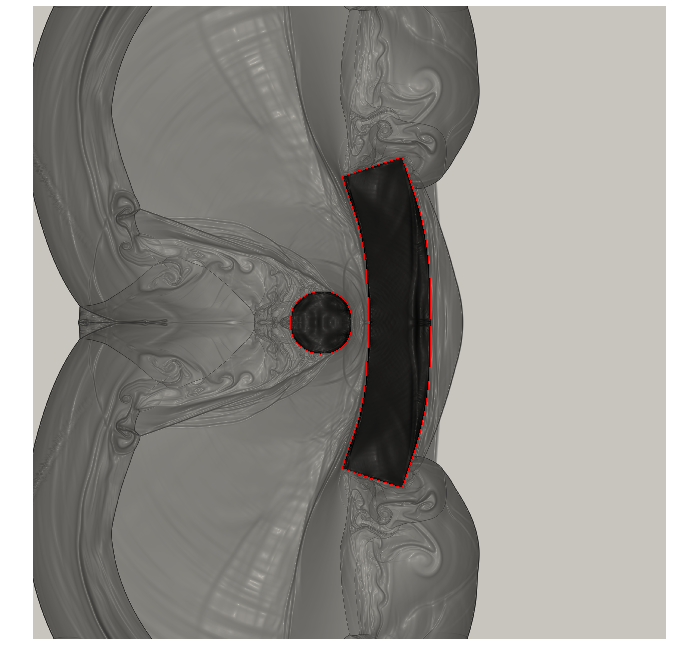
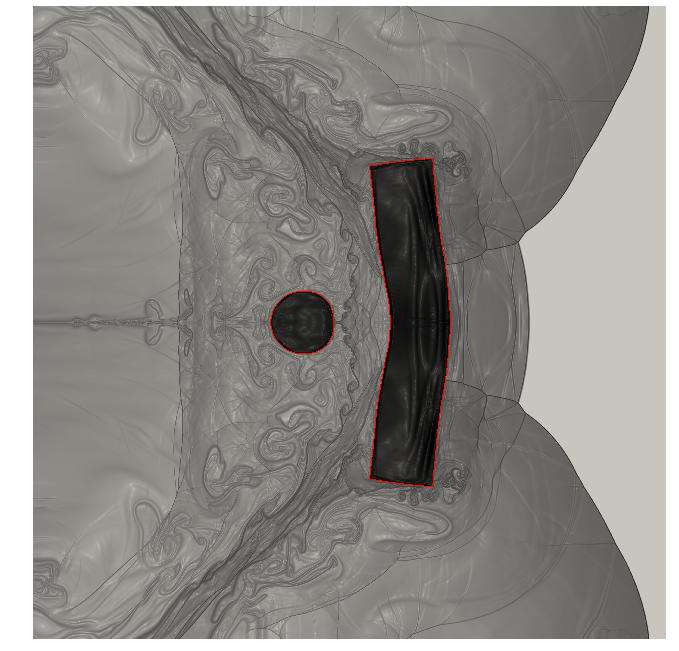
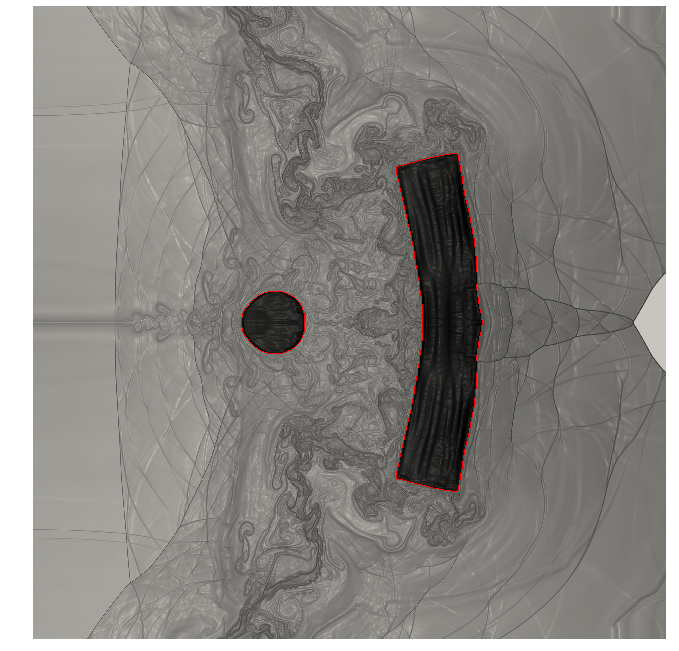
Impact simulation
In figure 6, we show the results of a three dimensional simulation of a cardiac pump (LVAD, left ventricule assisted device).
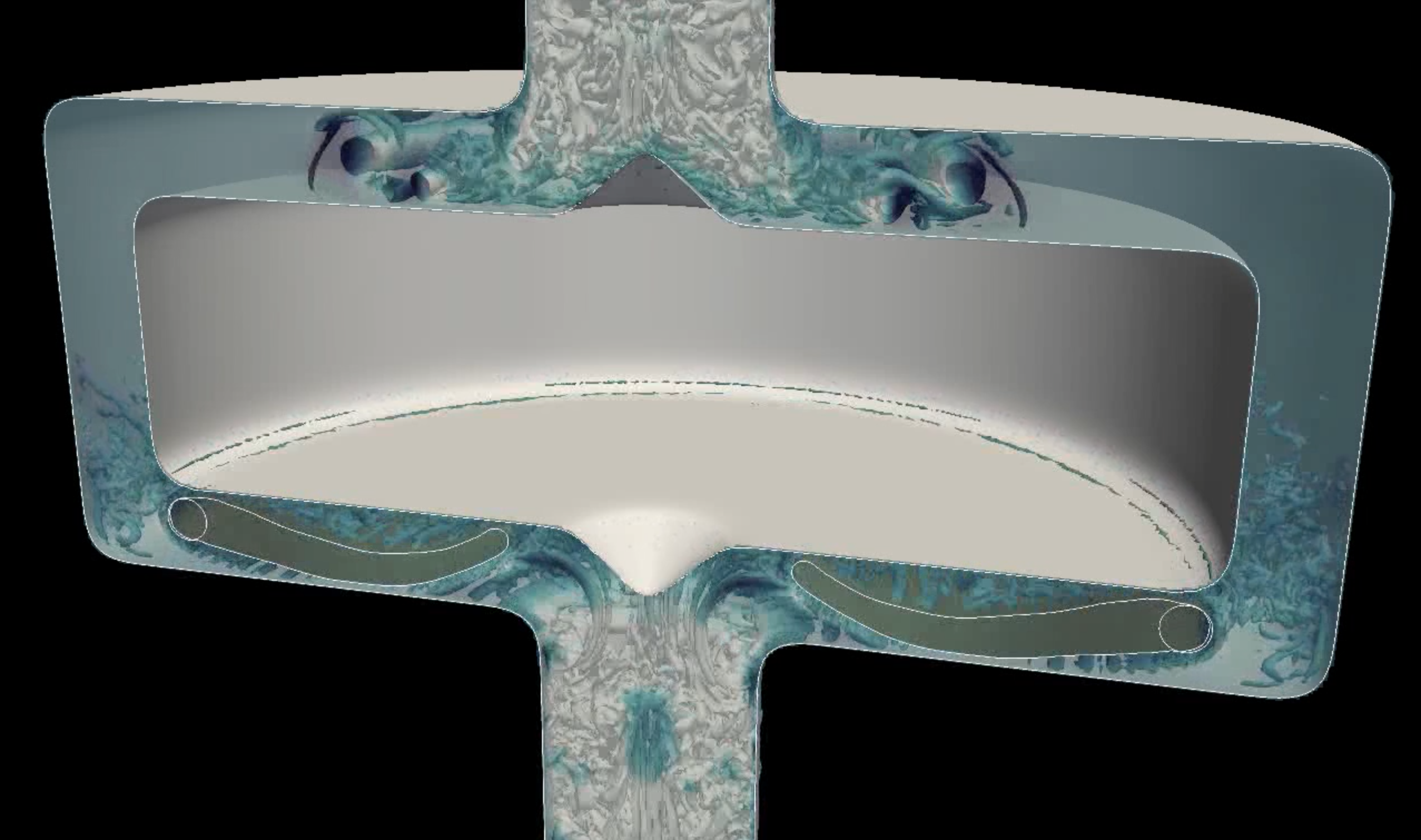
Cardiac pump simulation
5 Social and environmental responsibility
As discussed in the previous section, we are particularly interested in the development of mathematical models and numerical methods to study problems related to renewable energies, and ultimately contribute to next-generation sustainable solutions for energy extraction.
5.1 Impact of research results
We are studying two types of green energy extractors: wave energy converters (WECs) and wind energy.
As regards WECs, we are working with the PoliTO (Torino, Italy) to model the behavior of inertial sea wave energy converters (ISWEC), and we are also working with a Bordeaux-based start-up for another device to extract energy from waves via an Inria-Tech project and a Nouvelle-Aquitaine Regional Project submitted by Memphis in collaboration with the CARDAMOM team.
As regards wind energy, we focus on the analysis of wind turbines. In the past, we have supervised two PhD CIFRE theses with VALOREM-Valeol, and are currently working with them in a European RISE ARIA project led by Memphis. We also work with IFPEN on the aeroelastic modeling of large wind turbines and the study and optimization of turbines farms in the framework of the joint laboratory Inria-IFPEN with a thesis funded by IFPEN and a post-doc funded by Inria (which started in October 2021).
In conjunction with these activities, in collaboration with ANDRA (the national agency for storage of nuclear waste), we investigated the development of reduced-order models to allow efficient and accurate simulations for deep geological storage planning. This activity was the subject of the PhD thesis of Giulia Sambataro who successfully defended her PhD thesis in December 2022.
6 Highlights of the year
Model order reduction by convex displacement interpolation.
In 31, Cucchiara et al. extended the nonlinear interpolation technique of 41 to deal with multi-dimensional parameter domains and with datasets of several snapshots. The method of 41, which is dubbed convex displacement interpolation (CDI), relies on optimal transportation to perform accurate nonlinear interpolations between two solution snapshots. The method of 31 combines a boundary-aware registration procedure with a regression technique to properly exploit datasets with more than two snapshots for interpolation and to cope with multi-dimensional parameter domains.
During the training (offline) stage, the method in 31 exploits a feature extraction technique to identify point clouds for each snapshot in the training set; then, it relies on a point-set registration technique to match point clouds for different snapshots; during the prediction (online) stage, we first rely on a regression algorithm to predict the position of the point cloud; then, we apply a boundary-aware registration technique to define bijective mappings that deform the new point cloud into the point clouds of the neighboring elements of the dataset, while preserving the boundary of the domain; finally, we define the estimate as a weighted combination of modes obtained by composing the neighboring snapshots with the previously-built mappings. We demonstrate the accuracy of the method through the vehicle of several numerical examples for compressible and incompressible, viscous and inviscid flows. Furthermore, we employ the nonlinear interpolation procedure to augment the dataset of simulations for linear-subspace projection-based model reduction: our data augmentation procedure is designed to reduce offline costs (which are dominated by snapshot generation) of model reduction techniques for nonlinear advection-dominated problems.
In Figure 7, we illustrate the performance of the method for the compressible flow past a RAE2822 airfoil for varying inflow Mach number and angle of attack. Figures 7(a) and (b) show the behavior of the pressure coefficients for two different parameter values; Figures 7(c) and (d) show the prediction of the pressure coefficient on lower (LOW) and upper (UP) sides of the blade of linear and nonlinear interpolation for an out-of-sample configuration. We notice that the nonlinear interpolation strategy is quantitively and qualitatively more accurate than the linear counterpart, for the same amount of offline datapoints.
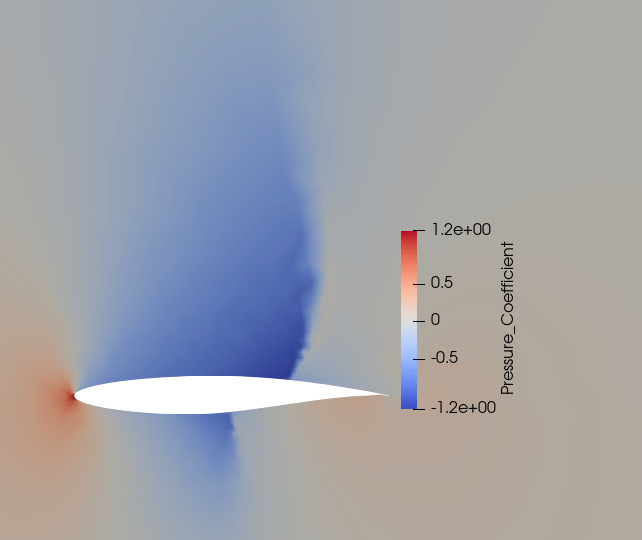
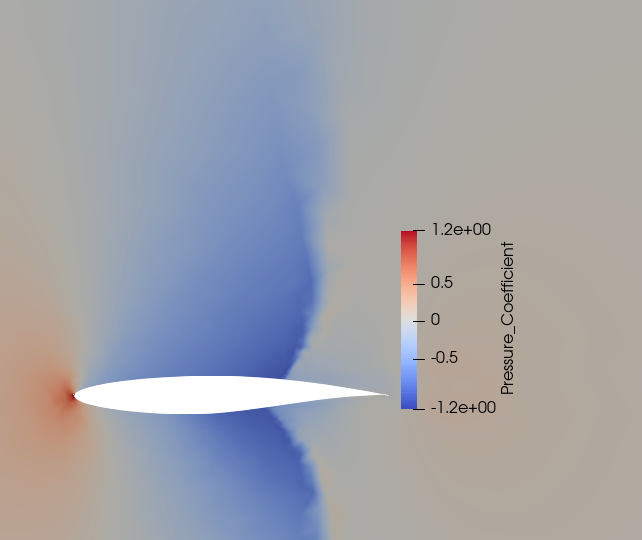
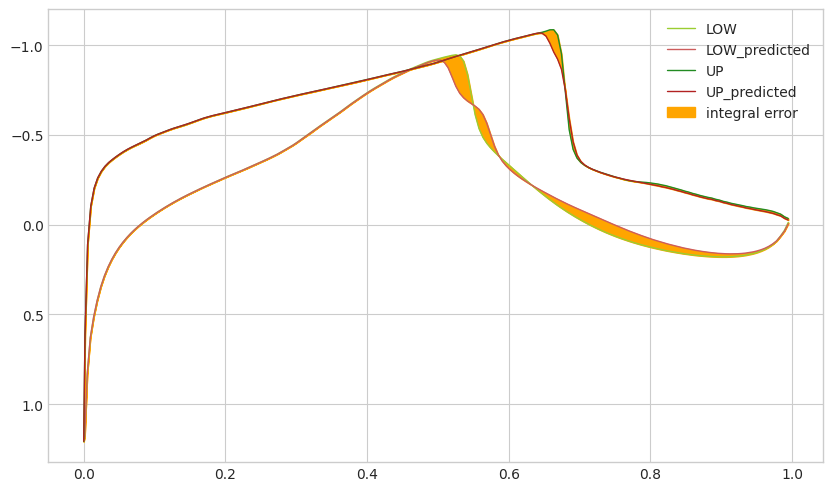
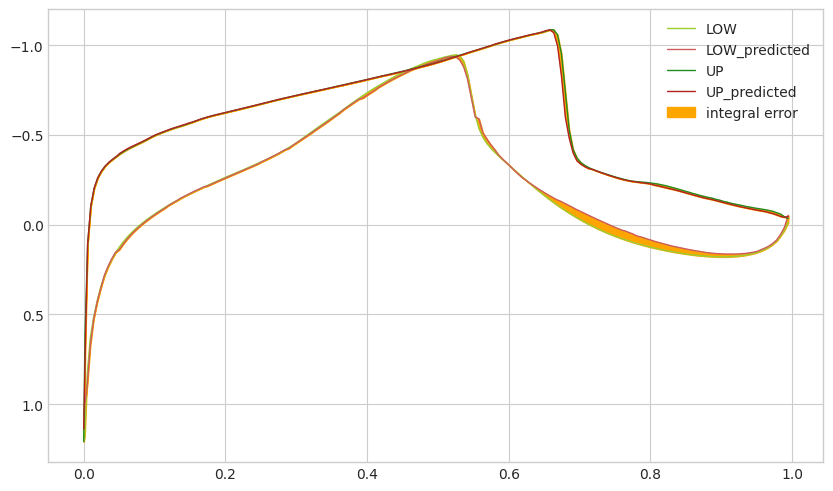
7 New software, platforms, open data
7.1 New software
7.1.1 COCOFLOW
-
Keywords:
3D, Elasticity, MPI, Compressible multimaterial flows
-
Functional Description:
The code is written in fortran 95 with a MPI parallelization. It solves equations of conservation modeling 3D compressible flows with elastic models as equation of state.
- URL:
-
Authors:
Alexia De Brauer, Florian Bernard, Yannick Gorsse, Thomas Milcent, Angelo Iollo
-
Contact:
Florian Bernard
-
Partners:
CNRS, Université Bordeaux 1
7.1.2 KOPPA
-
Name:
Kinetic Octree Parallel PolyAtomic
-
Functional Description:
KOPPA is a C++/MPI numerical code solving a large range of rarefied flows from external to internal flows in 1D, 2D or 3D. Different kind of geometries can be treated such as moving geometries coming from CAO files or analytical geometries. The models can be solved on Octree grids with dynamic refinement.
- URL:
-
Contact:
Angelo Iollo
-
Participant:
Florian Bernard
7.1.3 NaSCar3D
-
Name:
Navier-Stokes Cartesian 3D
-
Keywords:
HPC, Numerical analysis, Fluid mechanics, Langage C, PETSc
-
Scientific Description:
NaSCar can be used to simulate both hydrodynamic bio-locomotion as fish like swimming and aerodynamic flows such wake generated by a wind turbine.
-
Functional Description:
This code is devoted to solve 3D-flows in around moving and deformable bodies. The incompressible Navier-Stokes equations are solved on fixed grids, and the bodies are taken into account thanks to penalization and/or immersed boundary methods. The interface between the fluid and the bodies is tracked with a level set function or in a Lagrangian way. The numerical code is fully second order (time and space). The numerical method is based on projection schemes of Chorin-Temam's type. The code is written in C language and use Petsc library for the resolution of large linear systems in parallel.
NaSCar can be used to simulate both hydrodynamic bio-locomotion as fish like swimming and aerodynamic flows such wake generated by a wind turbine.
- URL:
-
Contact:
Michel Bergmann
-
Participant:
Michel Bergmann
-
Partner:
Université de Bordeaux
7.1.4 NS-penal
-
Name:
Navier-Stokes-penalization
-
Keywords:
3D, Incompressible flows, 2D
-
Functional Description:
The software can be used as a black box with the help of a data file if the obstacle is already proposed. For new geometries the user has to define them. It can be used with several boundary conditions (Dirichlet, Neumann, periodic) and for a wide range of Reynolds numbers.
-
Contact:
Charles-Henri Bruneau
-
Partner:
Université de Bordeaux
7.1.5 HiWind
-
Keyword:
Simulation
-
Functional Description:
Hiwind is a software that allows to model in 2D and 3D the effects of air flow on a wind turbine blade (moving solid or elastic structures), and to simulate numerically their interactions. Hiwind also allows to model and characterize the abnormal behavior to warn about a potential weakening of the structure. Hiwind is a "drag and drop" solution (automated meshing phase), massively parallel, and uses adaptive meshing.
-
Authors:
Claire Taymans, Angelo Iollo, Michel Bergmann
-
Contact:
Angelo Iollo
-
Partner:
Valeol
7.1.6 NEOS
-
Keyword:
Octree/Quadtree
-
Functional Description:
NEOS is a software framework for numerical modeling of multiphysical problems on hierarchical Cartesian meshes (quadtree in 2D and octree in 3D). It is mainly based on the bitpit library (https://optimad.github.io/bitpit/). NEOS provides : - the creation and parallel management of hierarchical Cartesian meshes (2D quadtree or 3D octree) - global or local mesh refinement (based on a distance of levelset or other physical criteria) - the management of several moving geometries in an analytical or explicit form (STL files or others) - the calculation of geometries levelsets at any point of the mesh - 2D/3D differential operators of (gradient, laplacian, hessian, ...) - various 2D/3D interpolators (bilinear, radial basis functions RBF) - an API for solvers (currently with PETSC) - a complete Python3 interface
-
Authors:
Angelo Iollo, Michel Bergmann, Philippe Depouilly, Laurent Facq, Antoine Fondaneche, Florian Bernard, Antoine Gerard, Matías Hastaran
-
Contact:
Michel Bergmann
-
Partner:
CNRS
8 New results
8.1 Component-based model order reduction for radioactive waste management
Participants: Angelo Iollo, Giulia Sambataro, Tommaso Taddei.
At the end of their cycle, radioactive materials are placed in arrays of cylindrical boreholes (dubbed alveoli) deep underground; due to the large temperatures of the radioactive waste, the thermal flux generated by the alveoli drives a complex time-dependent phenomenon which involves the thermal, hydraulic and mechanical (THM) response of the medium. The role of simulations is to predict the long-term system response and ultimately assess the impact of the repository site to the surrounding areas: Figure 8(a) shows a typical system configuration considered for numerical investigations.
Due to the complex nature of the equations (a system of five coupled nonlinear time-dependent three-dimensional equations) and due to the uncertainty in several parameters of the model and on boundary conditions, MOR techniques are important to reduce the computational burden associated with thorough parametric studies. In particular, it is important to study the system behavior for different numbers of alveoli: it is possible to show that changing the number of alveoli induces a change in the topology of the problem and thus prevents the application of standard monolithic MOR techniques developed for fixed domains or diffeomorphic families of parametric domains. We should thus devise component-based MOR procedures that are compatible with topology changes.
The PhD project of Giulia Sambataro aimed to devise a rapid and reliable component-based MOR technique for THM systems, for radioactive waste management applications. During the first year of her PhD, Giulia developed a monolithic MOR technique for THM systems which relies on a POD-Greedy algorithm to sample the parameter domain and to hyper-reduction based on empirical quadrature to reduce online prediction costs. During the second and third year, Giulia developed a component-based MOR formulation — which is dubbed one-shot overlapping Schwartz (OS2) method — for nonlinear steady PDEs and finally she extended the approach to THM systems with varying numbers of alveoli.
Giulia successfully defended her PhD thesis in December 2022; her work led to the publication of two articles on peer-reviewed journals, 40 and 15. Figure 8(b) shows the temporal behavior of the HF and predicted pressure and temperature in a select point in the proximity of one alveolus for an out-of-sample configuration. We observe that the ROM is able to adequately predict the solution behavior; in our numerical experiments, we experienced an average 20x speed-up over the range of configurations.
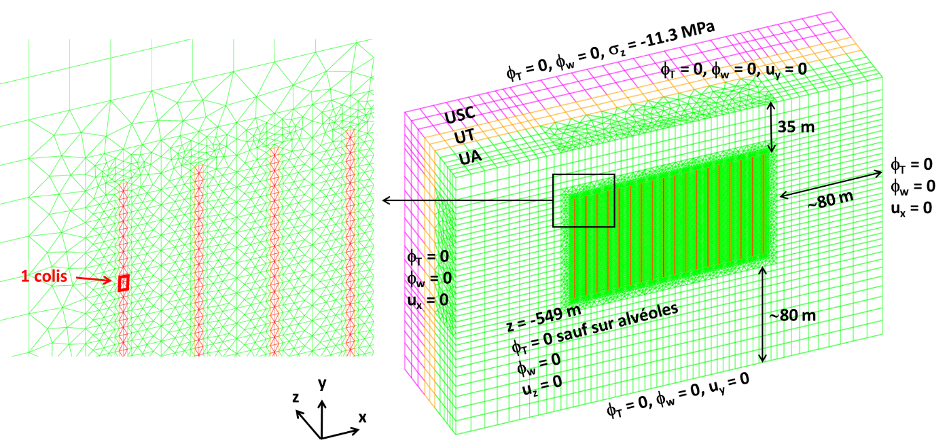
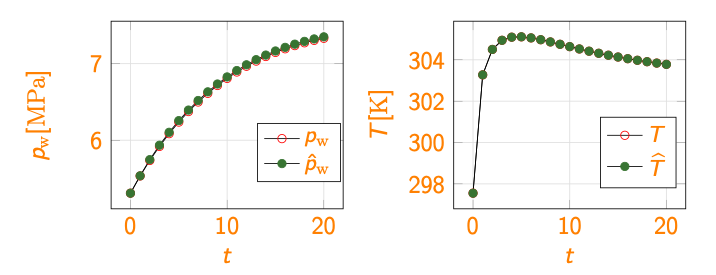
HM model problem
8.2 Registration methods for advection-dominated PDEs
Participants: Angelo Iollo, Tommaso Taddei.
A major issue of state-of-the-art MOR techniques based on linear approximation spaces is the inability to deal with parameter-dependent sharp gradients, which characterize the solutions to advection-dominated problems. To address this issue, we propose a registration technique to align local features in a fixed reference domain. In computer vision and pattern recognition, registration refers to the process of finding a transformation that aligns two datasets; here, registration refers to the process of finding a parametric spatio-temporal transformation that improves the linear compressibility of the solution manifold.
A registration procedure has been proposed in
45 and then further developed in 47, 46, 36.
In particular, in 47, we considered the application to one-dimensional applications in hydraulics; in an ongoing collaboration with EDF, we aim to extend the approach to two-dimensional steady and unsteady problems. Figure 9 shows results for a Saint-Venant problem (flow past a bump):
Figures 9(a) and 9(b) show the free surface

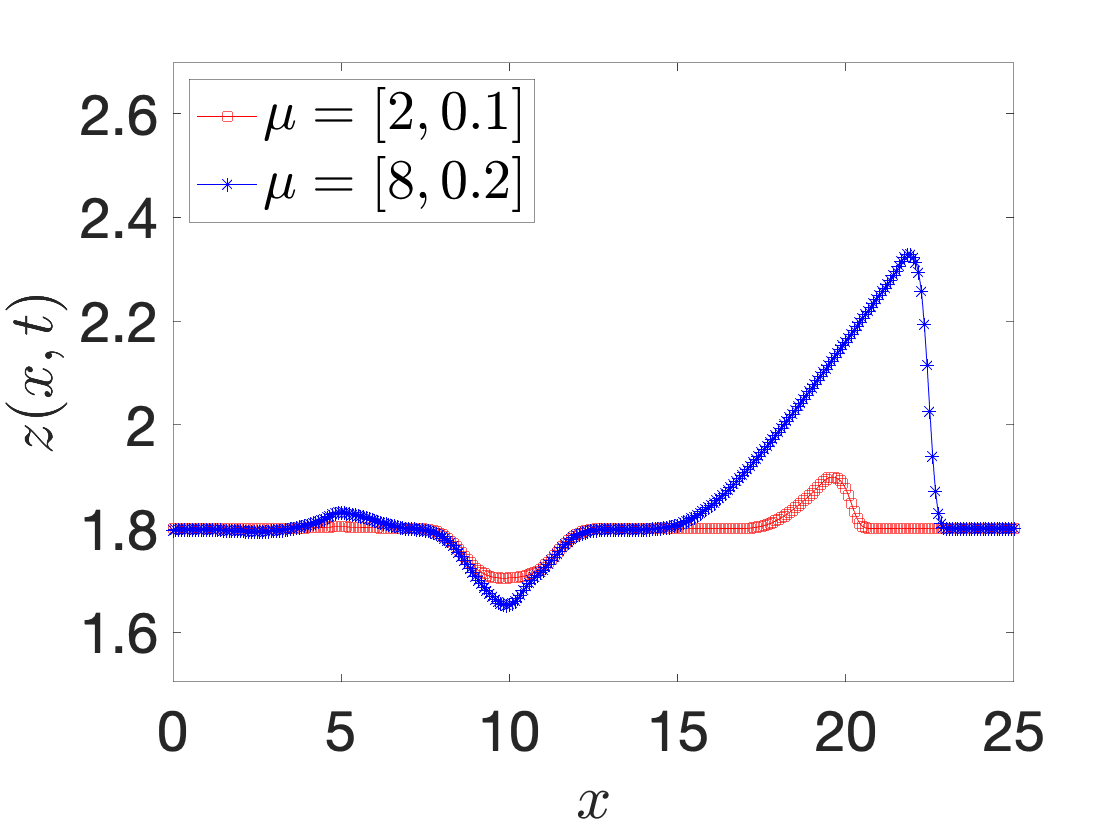

Space time registration
In 41, Iollo and Taddei proposed a general (i.e., independent of the underlying PDE) nonlinear interpolation technique based on optimal transportation of Gaussian models of coherent structures of the flow.
In 31, Cucchiara et al. extended such a technique to deal with multi-dimensional parameter domains and with datasets of several snapshots. The method of 41 relies on optimal transportation to perform accurate nonlinear interpolations between two solution snapshots. The method of 31 combines a boundary-aware registration procedure with a regression technique to properly exploit datasets with more than two snapshots for interpolation and to cope with multi-dimensional parameter domains. See the Highlights section 6 for more information.
8.3 Aortic aneurysms: automatic segmentation and registration
Participants: Angelo Iollo, Gwlady Ravon, Sebastien Riffaud, Ludovica Saccaro.
In 37, we developed a new artificial neural network to automatically segment aortic aneurysm. The main idea with this approach was to consider each pixel of the image individually and to see if a model could learn how to categorize it as lumen only from its own intensity and the intensity of its 26 neighbors. We tested different inputs (values, means, variances...) and architectures: a sequential model was retained. For the input, each sample is a vector of 27 intensity values. Only pixels whose intensity is between 100 and 700 are kept for training and prediction.
The second axis of development concerned registration. In her PhD, Ludovica Saccaro presents several complete and automated working pipelines for clinical applications, for the pathology of abdominal aortic aneurysm. Her work is based on a mathematical modeling of aneurysm geometry, used for registration, risk assessment using a reduced modeling approach, and a generative algorithm. First, she introduced the geometric modeling technique, using B-spline functions and Fourier series for modeling. The geometric modeling presented in this work ensures the isolation of the aortic vessel, even in the presence of secondary vessels, while smoothing and regularizing its shape. The entire modeling process is automated, making it a crucial step for clinical support in aneurysm pathology. It aims to ensure that different geometrical shapes are comparable in a mathematical sense. To highlight the practical application, she integrated the modeling into a registration pipeline for clinical diagnosis and follow-up, providing automated tools for quantitative measurement and qualitative indication of disease progression by mathematically standardizing the aneurysm shape. Looking ahead, the registration pipeline could track the entire pathology, enabling close monitoring of patient-specific aneurysm evolution for valuable data in population studies, prevention and surgical planning. Then, she extended the use of the modeling as a basis for hemodynamic simulations, aiming to create a pipeline for constructing a projection space to assess abdominal aneurysm risk. The space created is meant to be used in a predictive sense, namely to derive hemodynamical quantities solely from geometry, to maintain the patient-specific approach, and on a dataset of previous simulations. The same procedure could be applied to other indicators, such as the pressure field or the WSS, as the choice of the indicator does not impact any steps in the proposed procedure, which remains a key achievement of our work. The limited accuracy of the approximated fields is partly due to the lack of a large amount of data, and the absence of personalized boundary conditions for each patient. In this context, she also proposed an automated pipeline that starts from the geometrical modeling and outputs synthetic aneurysm shape, by creating a mathematical space for modeling aortic aneurysms, using reduced-order model techniques. This part of the work is of interest since in clinical settings datasets are often scarce, and synthetic data emerged as a promising solution.
The PhD thesis of Ludovica Saccaro is expected to be defended in February 2023. A paper is in preparation.
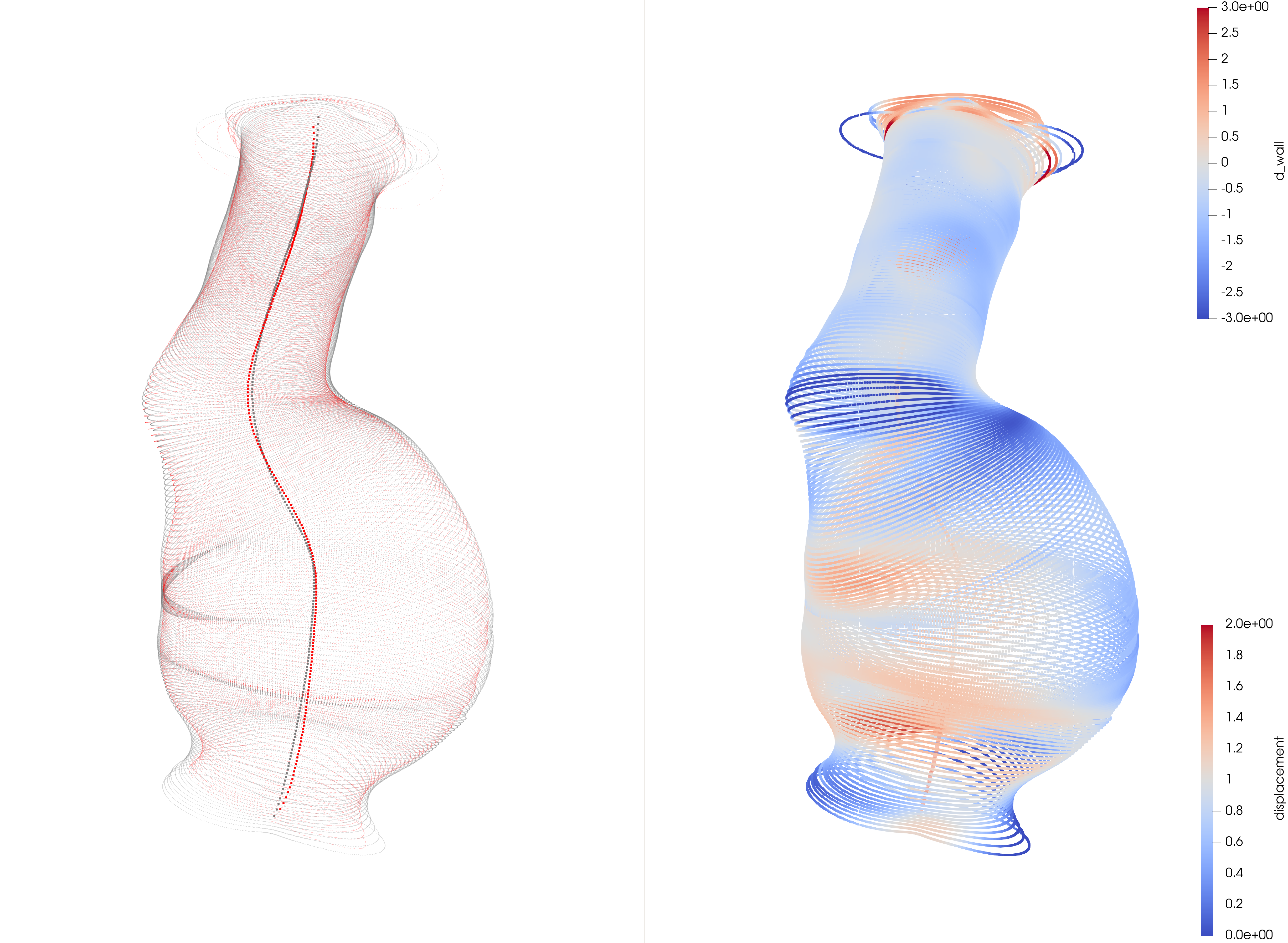
Aneurysm geometries
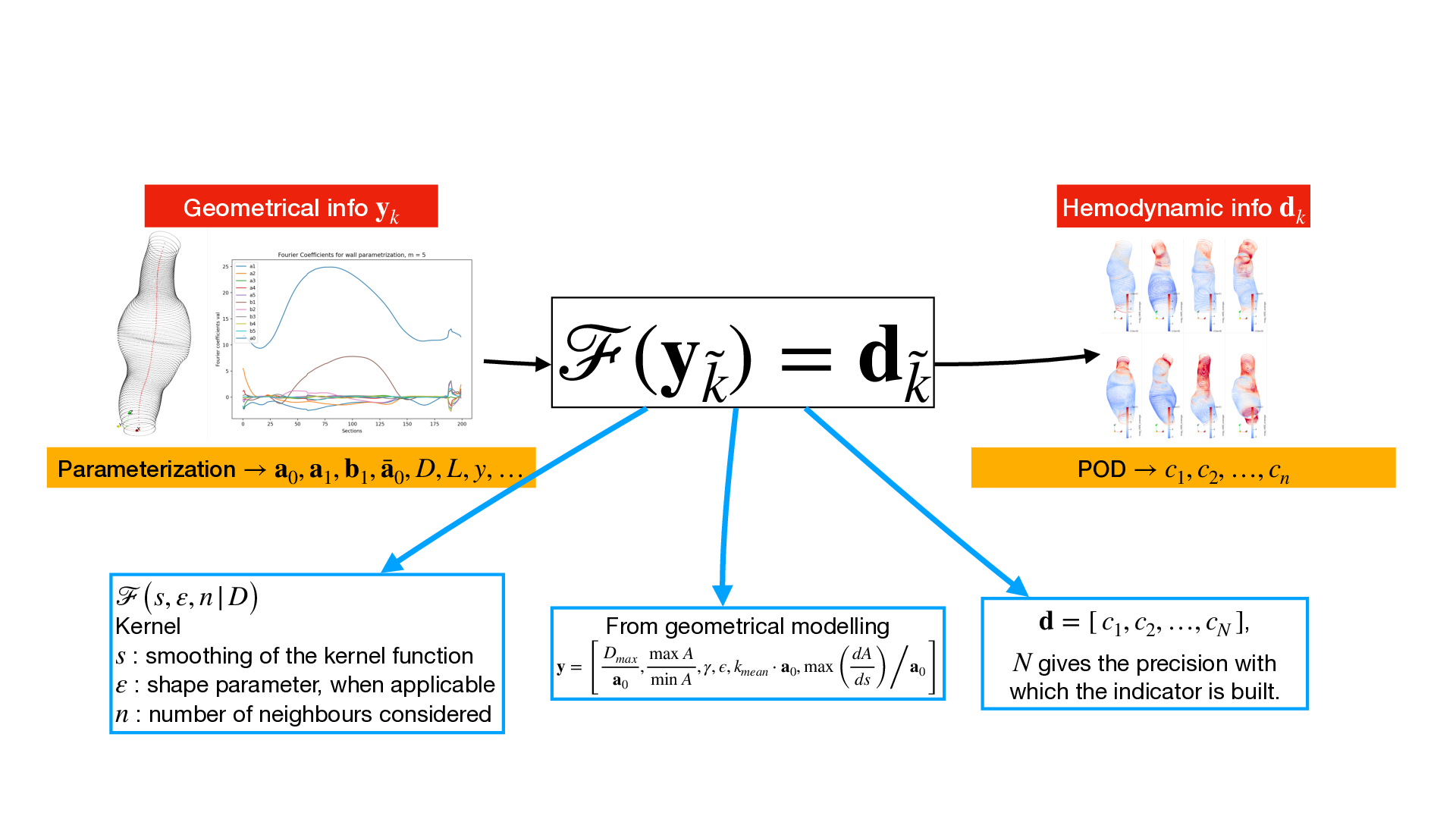
Aneurysm geometries
8.4 Model reduction for aerodynamic applications
8.4.1 Deep learning wall laws for aerodynamic simulations
Participants: Michel Bergmann, Thomas Philibert, Angelo Iollo, Michele Romanelli.
The availability of reliable and accurate wall laws is one of the main challenges of modern Computational Fluid Dynamics (CFD). Wall models are mandatory for the application of large-scale turbulence (LES) simulations for flows representative of aeronautical applications, and they are also indispensable for Reynolds-Averaged-Navier-Stokes (RANS) simulations, either when using immersed boundary methods (IBM) methods, or for the implementation of light calculations useful for parametric studies, flow control or shape optimization, where multiples simulations are often required and the cumulative computational cost can become prohibitive. Wall laws help to lighten the computational load by replacing the resolution of the parietal flow (typically the most densely meshed zone) with a model. Given the complexity of phenomena that can be modeled thanks to the flexibility of neural networks neural networks, these methods show undeniable potential in their application to the modelling of flows.
The research objective is to propose a wall law based on deep learning algorithms applicable within the framework of Reynolds-Averaged-Navier-Stokes (RANS) simulations, outperforming conventional models in terms of accuracy and generality. In addition, the exploratory nature of this study aims to identify input quantities that would enable more reliable modeling of boundary layer development. A novel approach inspired by the Dirichlet-to-Neumann map is proposed, directly imposing viscous flow across the interface between the modeled region and RANS calculations. This involves a model composed of two interconnected neural networks: the first estimating viscous shear stress, and the second evaluating the wall-normal derivative of the velocity field. Both neural networks are trained using dimensionless data extracted from RANS simulations of flow over 2D bumps. Evaluating the model's performance involves comparing simulations with wall modeling to fully-solved calculations for flow configurations (over bumbs and airfoils) not encountered during neural network training. The robustness and accuracy of the wall model are evident in testing, demonstrating an ability to reproduce the friction coefficient with only a minimal error across all tested cases.

wall law
8.4.2 Clustered active subspaces for aerodynamic shape optimisation
Participants: Michel Bergmann, Maxime Chapron.
Shape optimisation has seen an increase of the number of design variables used, with finer geometry control enabling more precise results. However, this increase in dimensionality complexifies an already tough to optimise function such as drag. Gradient-based optimisers are powerful but local, and do not guarantee convergence towards the global optimum. On the other end of the spectrum, surrogate-based optimisation techniques are good global optimisers, but struggle in high-dimensional design spaces, due to the curse of dimensionality. Dimension reduction provides answers to this particular problem, and the Active Subspaces method has been shown to be a viable option, with the benefit of using gradient information to discover influential design parameters. We take Active Subspaces further by using a combination of them to identify linear manifolds in subregions of the design space, instead of trying to identify a single global trend. We are then free to train local surrogate models inside of these locally reduced spaces, where the reduced number of points and dimensions renders their training feasible. More specifically, the global surrogate modelling methodology was improved by paying special attention to the areas surrounding the boundaries between clusters 22. We defined overlapping zones between clusters by computing Euclidean distances to explicit cluster boundaries given by a nonlinear Support Vector Classifier. Data points within these zones are mutualised between neighbouring clusters, yielding improved accuracy near boundaries by reducing the need for local surrogate models to extrapolate. This was done to improve model accuracy without adding new data points, as well as to reduce uncertainty around these areas in order to prevent the Efficient Global Optimisation (EGO) procedure from wanting to add points in these areas, instead of near known minima.
The latter part of the year saw contributions to the EGO methodology, with the implementation of a stopping criterion based on estimations of the true, unknown minimum. Compared to usual EGO procedures which are carried out until a given computational budget runs out, this criterion allows an estimation of EGO performance in real time, and allows (for example) the switch to gradient descent once a certain level of convergence has been reached, drastically reducing the number of function evaluations needed to converge. We have also made improvements to the infill criterion maximisation methodology, further increasing efficiency. A paper on the EGO methodology is in preparation.
8.5 Projection-based model order reduction for parametric quasi-static nonlinear mechanics using an open-source industrial code
Participants: Eki Agouzal, Michel Bergmann, Tommaso Taddei.
In 11, we proposed a projection-based model order reduction procedure for a general class of parametric quasi-static problems in nonlinear mechanics with internal variables; the methodology is integrated in the industrial finite element code Code Aster. We developed an adaptive algorithm based on a POD-Greedy strategy, and we developed an hyper-reduction strategy based on an element-wise empirical quadrature, in order to speed up the assembly costs of the ROM by building an appropriate reduced mesh. We introduced a cost-efficient error indicator which relies on the reconstruction of the stress field by a Gappy-POD strategy. We presented numerical results for a three-dimensional elastoplastic system in order to illustrate and validate the methodology.
This approach was then extended to a multi-modeling industrial test-case 25. More specifically, we looked at a standard section of a power plant containment, consisting of reinforced concrete. Such numerical simulations involve a multi-modeling approach: a three-dimensional nonlinear thermo-hydro-visco-elastic rheological model is used for concrete; and prestressing cables are described by a one-dimensional linear thermo-elastic behavior. The methodology is validated on the fields and quantities of interest specific to engineers for this type of problem, on a mesh used in real-world engineering simulations.
8.6 Efficient Simulation of Wave Energy Converters
Participants: Beatrice Battisti, Michel Bergmann, Umberto Bosi, Giovanni Bracco, Martin Parisot.
In response to the evolving energy landscape, the marine sector is exploring wave energy converters (WECs) for clean energy generation. The deployment of WECs in farms is crucial for achieving commercial-scale production, necessitating preliminary numerical simulations due to complex hydrodynamics. Although conventional high-fidelity simulations are resource-intensive, they are essential for accurately capturing the complexities of highly nonlinear phenomena.
On the one hand, Beatrice Battisti (PhD student), Giovanni Bracco and Michel Bergmann works on a methodology that integrates a high-fidelity solver (CFD) for the near-field representation of floaters with a Reduced-Order Model (ROM) for far-field wave propagation. Information exchange between the two models occurs bidirectionally. From the CFD to the ROM models, information passes through the violet zones in Figure 13: a minimization problem is solved to determine the ROM solution that best approximates the high-fidelity solution in that region. Subsequently, the ROM solution is transmitted to the CFD as high-fidelity boundary conditions, considering the incoming wave. Through testing under various flow conditions and with a floating body, this methodology demonstrates accurate flow reconstruction and a comprehensive description of floater dynamics. In Figure 14, translations and forces acting on the body are depicted. The coupled model results (hf+POD) are illustrated for an in-sample reconstruction and an out-of-sample case, where snapshots from simulations of two different waves are utilized to obtain results for the test wave. The reference is the outcome from the high-fidelity simulation of the test wave across the entire domain (HF). The coupled model significantly reduces computational costs, thereby streamlining optimization and design processes for wave energy converter farms. One paper is in preparation.
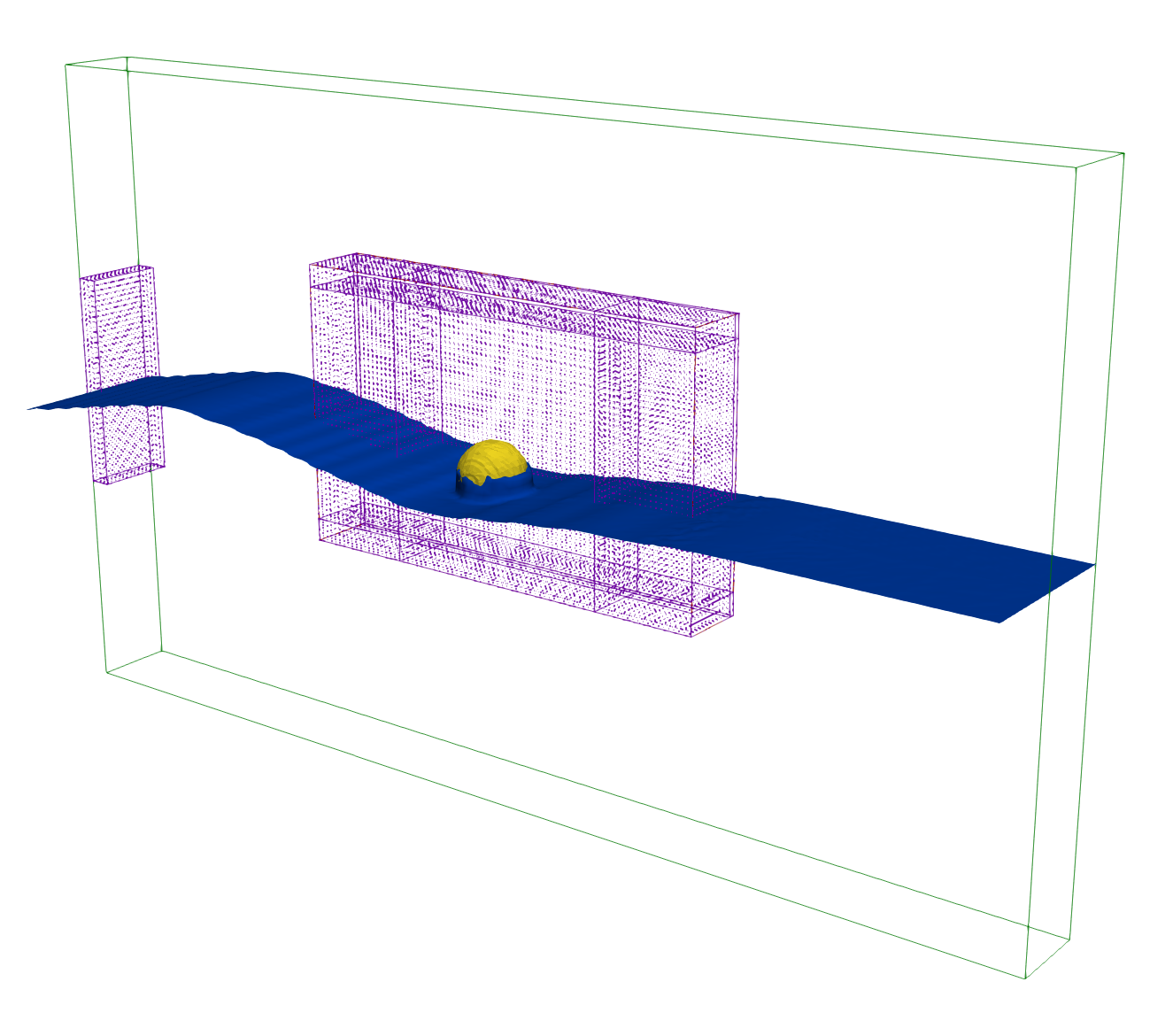
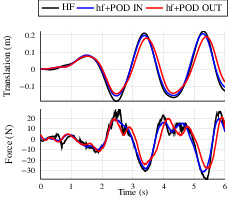
On the other hand, Umberto Bosi (post-doc), Michel Bergmann and Martin Parisot (Inria CARDAMOM) proposed a novel approach to simulate wave energy converters and their interactions with wave dynamics (paper in preparation). It couples a low performance, high fidelity Navier Stokes (NS) model that simulated the converter with the faster performances of asymptotic models such as Boussinesq (B) models for wave propagation. This approach allows to well capture the highly nonlinear and complex effects close to the structure thanks to the NS model and efficiently propagate the waves between structures such that even wave energy converters farm can be simulated precisely. They have demonstrated that their coupling approach, inspired by the perfectly matched layer technique, permits the transmission of waves from the B domain to the NS one without loss of informations. Moreover, reproducing the experiences of Beji and Battjes (1993) and Liu et al. (2019) of wave passing over a submerged hill, they have shown that the resulting waves preserve more informations on nonlinearities that a non coupled Boussinesq model.
9 Bilateral contracts and grants with industry
9.1 Bilateral contracts with industry
- Contrat accompagnement Cifre Ingeliance (M. Truel) - du 01/05/2023 au 30/04/2026
- Contrat accompagnement EDF (E. Agouzal) - du 01/04/2021 au 30/03/2024
- Contrat accompagnement IFPEN (C. Le Guern) - du 01/12/2021 au 30/11/2024
10 Partnerships and cooperations
10.1 International initiatives
10.1.1 Associate Teams in the framework of an Inria International Lab or in the framework of an Inria International Program
Participants: Michel Bergmann, Angelo Iollo, Tommaso Taddei.
MARE
- Title: Multiscale Accurate Reduced-order model Enablers
- Duration: 2019-2023
- Coordinator: Charbel Farhat (cfarhat@stanford.edu)
- Partner: Stanford University Stanford (United States)
- Inria contact: Angelo Iollo
- Summary: Reduced-order models (ROMs) are simplified mathematical models derived from the full set of partial differential equations governing the physics of the phenomenon of interest. We focus on ROMs that are data-driven as they are based on relevant solution data previously obtained. In particular we will focus on multiscale adaptive models where the large scales are governed by a PDE and the small scales are described by data driven models. To do that we will leverage on tools from data geometry, numerical PDEs and machine learning.
10.2 International research visitors
10.2.1 Visits of international scientists
Michele Giuliano Carlino, University of Ferrara, from February 2023 to September 2023.
10.3 European initiatives
10.3.1 H2020 projects
ARIA
ARIA project on cordis.europa.eu
-
Title:
Accurate Roms for Industrial Applications
-
Duration:
From December 1, 2019 to November 30, 2024
-
Partners:
- INSTITUT NATIONAL DE RECHERCHE EN INFORMATIQUE ET AUTOMATIQUE (INRIA), France
- ESTECO SPA (ESTECO), Italy
- NUREA, France
- VALOREM SAS (valorem), France
- SCUOLA INTERNAZIONALE SUPERIORE DI STUDI AVANZATI DI TRIESTE (SISSA), Italy
- IEFLUIDS S.R.L., Italy
- POLITECNICO DI TORINO (POLITO), Italy
- POLITECNICO DI MILANO (POLIMI), Italy
- OPTIMAD ENGINEERING SRL (Optimad srl), Italy
- UNIVERSITY OF SOUTH CAROLINA (USC), United States
- VOLKSWAGEN AKTIENGESELLSCHAFT (VW AG), Germany
- VIRTUALMECHANICS SL (VM), Spain
- VIRGINIA POLYTECHNIC INSTITUTE AND STATE UNIVERSITY (VT), United States
- UNIVERSITA CATTOLICA DEL SACRO CUORE (UCSC), Italy
- BOARD OF TRUSTEES OF THE LELAND STANFORD JUNIOR UNIVERSITY (STANFORD), United States
- UNIVERSIDAD DE SEVILLA, Spain
-
Inria contact:
Angelo IOLLO
-
Summary:
The project Accurate Roms for Industrial Applications aims at developing an array of mathematical methods for constructing predictive reduced-order models (ROMs) with guaranteed accuracy, robustness, reliability and efficiency for applications involving complex physical phenomena. New approaches to this challenge are proposed here with a focus on the Euler and Navier–Stokes equations of fluid flow, two of the most challenging continuum models with an extraordinary rich range of industrial applications. The mathematical modeling and solution of the Euler and Navier-Stokes equations is sometimes cited as the greatest challenge in continuum modeling of physical phenomena. This topic is selected as our principal focus because of its intrinsic importance, but also because the mathematical methods developed in addressing this very challenging task may well have an impact on other fields of knowledge. We plan to tackle these challenging objectives in this staff exchange program by combining the unique expertise of our extended research team whose members have made significant progress in ROM research during the past decade. This academic expertise is cross-fertilized by the exchange with knowledge intensive SMEs ans start up and well established industrial partners that will benefit from the scientific and technological results of the team and will challenge the solutions found with applications in real world problems.
10.4 National initiatives
-
ANR (national agency for research funding)
DRAGON2.
- Principal investigators: Michel Bergmann.
- Partners: CNRS/Université de Poitiers/Inria. 27 k€+ 1 PhD.
- Summary: The goal is study the aquatic swimming a several snakes using biomimetism and bioinspiration. In this project, we have experimental data for snake swimming, and we are building a numerical twin to compute integral quantities like the efficiency. Reinforcement learning is also considered to optimize the snake swimming.
-
ANR (national agency for research funding)
RedLum.
- Principal investigators: Tommaso Taddei.
- Partners: Team ACTA at INRAE Rennes.
- Summary: REDLUM is a joint project between the team ACTA at INRAE Rennes and the team MEMPHIS at Inria Bordeaux; the project will fund a PhD thesis in October 2024: the selected student will join team MEMPHIS in Bordeaux and will work closely with the other partners of the project. The objective of REDLUM is to develop a model reduction procedure for turbulent flows with unknown boundary conditions; the ultimate goal is to devise a rapid and reliable simulation tool to tackle real-time data assimilation tasks in agricultural sciences. The distinctive methodological feature of the approach that we wish to develop is a stochastic closure model to adequately approximate the dynamics of the low-dimensional coherent structures of the system.
-
Inria Exploratory Action: AM2OR (Adaptive meshes for model order reduction).
- Principal investigators: Nicolas Barral (Inria team: Cardamom), Tommaso Taddei. 14 k€+ 1 PhD + 1 PostDoc.
- Summary: Mesh adaptation and model order reduction both aim at reducing significantly the computational cost of numerical simulations by taking advantage of the solution's features. Model order reduction is a method that builds lighter surrogate models of a system's response over a range of parameters, which is particularly useful in the solution of design and optimization inverse problems. Reduced-order models rely on a high-fidelity (e.g., finite element) approximation that should be sufficiently accurate over the whole range of parameters considered: in presence of structures such as shocks and boundary layers, standard mesh refinement techniques would lead to high-fidelity models of intractable size. In this project, we propose a novel adaptive procedure to simultaneously construct a high-fidelity mesh (and associated discretisation) and a reduced-order model for a range of parameters, with particular emphasis on inverse problems in computational fluid dynamics.
10.5 Regional initiatives
Chaire Onera-Nouvelle Aquitaine PROpulsion Verte (PROVE)
- Duration: 2022-2027
-
Summary: The Chair is dedicated to the development of reduced models at the crossroads between PDE modelling and machine learning, with application to aerodynamics for propulsion. The Chair has 6 PhD students, 2 post-docs and a budget for research activities (internships, missions). 4 theses have already been launched. The Chair has a budget of 1.2M€.
The project is led by Dr. Denis Sipp at ONERA and Prof. Angelo Iollo at INRIA Bordeaux.
11 Dissemination
11.1 Promoting scientific activities
11.1.1 Scientific events: organisation
Michel Bergmann, Angelo Iollo and Tommaso Taddei organized the ARIA 1st Workshop in Bordeaux from 08/03/2023 to 10/04/2023. The workshop was on Reduced Order Models and aimed to progress towards key advances in modeling multi-scale nonlinear physical phenomena. This workshop was supported by: the European Commission, Inria Bordeaux, CNRS and Bordeaux University.
Michel Bergmann organized the minisymposium "Advances in embedded and Eulerian methods for fluid-structure interaction" at ICIAM, Tokyo.
11.1.2 Invited talks
- Michel Bergmann: January 16. An overview of current research in model order reduction at INRIA. Seminar at Sandia Livermore.
- Alessia Del Grosso: November 28. From hypersonic to low Mach flows using multi-point numerical methods. Strasbourg. Seminar at IRMA.
- Alessia Del Grosso: December 5. Entropy stable, positivity preserving and well-balanced multi-point schemes for 2D shallow water system. Chai du Château d’Eyran. Journée du LRC Anabase.
- Angelo Iollo: March 15. Discussion of Some Examples of Linear or Nonlinear, Intrusive or Non-intrusive Reduced Models based on Convex Displacement Interpolation. Paris. Seminar at SafranTech.
- Angelo Iollo: November 21. Retour sur la publication "Enablers for robust POD models" (Bergmann, Bruneau, Iollo, JCP, 2009): Pourquoi j’ai changé d’avis sur tout ou presque. Paris. Seminar at CNAM.
- Angelo Iollo: November 22-24. Model Reduction by Convex Displacement Interpolation. Paris-Saclay. Mortech conference.
11.2 Teaching - Supervision - Juries
11.2.1 Teaching
Two members of the team are Professor (Angelo Iollo) or Assistant Professor (Afaf Bouharguane) at Université de Bordeaux and have teaching duties, which consist in courses and practical exercises in numerical analysis and scientific computing. Michel Bergmann (CR) also teaches around 64 hours per year (practical exercises in programming for scientific computing). Tommaso Taddei (CR) also teaches around 50 hours per year (practical exercises in numerical analysis and scientific computing).
11.2.2 Supervision
- 2021-2024. Eki Agouzal, Cifre (Industrial thesis), EDF. Estimation de l’état mécanique d’enceintes de confinement par assimilation de données provenant de la maquette Vercors. Advisors: Michel Bergmann, Tommaso Taddei.
- 2020-2023. Beatrice Battisti, Politecnico di Torino. Multi-fidelity multi-scale numerical modelling of wave energy converters farms. Advisors: Michel Bergmann, Giovanni Bracco.
- 2022-2025. Maxime Chapron, ONERA. Active Subspaces for Dimension Reduction Applied to Aerodynamic Shape Optimisation. Advisor: Michel Bergmann.
- 2022-2025. Jon Labatut. Bourse Onera. Interpolation de déplacement convexe. Advisors: Angelo Iollo, Tommaso Taddei.
- 2021-2024. Caroline Le Guern, Ifpen. Modelisation de l’aero-elasticité en grandes transformations par un couplage partitioné: application aux grandes eoliennes. Advisor: Michel Bergmann.
- 2021-2024. Karl Maroun, Université de Poitiers (ANR Dragon2). Biomimetism and bioinspiration of a snakes’s anguilliform swimming: numerical twin and machine learning. Advisors: Michel Bergmann, Philippe Traoré.
- 2023-2026. Abdessamad Moussaddak, thèse CIFRE EDF. Model reduction for river and coastal hydraulics. Advisors: Astrid Decoune, Angèlique Ponçot, Tommaso Taddei.
- 2020-2023. Thomas Philibert. Bourse Politecnico di Torino. Convergence entre modèles et données pour la simulation d’écoulements turbulents en propulsion aéronautique. Advisors: Angelo Iollo, Francesco Larocca.
- 2021-2024. Michele Romanelli, Chaire ONERA. Lois de Paroi à Apprentissage Profond pour Simulations Aérodynamiques. Advisors: Héloïse Beaugendre, Michel Bergmann.
- 2020-2023. Ludovica Saccaro. Bourse Inria. Identification de biomarqueurs mécaniques pour l’évaluation du risque de rupture d’anévrismes aortiques abdominaux. Advisors: Angelo Iollo.
- 2021-2024. Alexis Tardieu. Bourse ministère. DG sur maillage hierarchique. Advisors: Afaf Bouharguane, Angelo Iollo.
- 2022-2025. Ishak Tifouti, Inria Exploratory Action, AM2OR project. Registration-based model reduction with mesh adaptation. Advisors: Nicolas Barral, Tommaso Taddei.
- 2023-2026. Mathias Truel. Thèse CIFRE Ingeliance. Modèles hybrides instationnaires pour l’interaction fluide structure. Advisors: Michel Bergmann, Angelo Iollo.
11.2.3 Juries
Angelo iollo: Reviewer of the PhD thesis of Paola Allegrini (Institut de Mathématiques de Toulouse) 20/09/23. President of the HDR jury of Laurent Monasse (Nice) 12/20/23. Member of the PhD jury of Stefano Piccardo (Université Polytechnique de Catalogne) 04/12/23. Member of the Jury Chaire Calcul Scientifique CNAM, Paris, 04/23. Member of the Jury Concours CR INRAE, 04/23. Member of the Comité de recrutement Ingénier de recherche Onera, 04/23.
Michel Bergmann: Reviewer of the PhD thesis of Yohan Poirier (Ecole centrale de Nantes).
11.3 Popularization
11.3.1 Internal or external Inria responsibilities
Michel Bergmann has been promoted to DR2 (senior researcher).
Angelo Iollo. Named to the departmental council of "Sciences du Numérique et Ingénierie" of the University of Bordeaux. 2019-2023.
12 Scientific production
12.1 Major publications
- 1 articleAn all-speed relaxation scheme for gases and compressible materials.Journal of Computational Physics3512017, 1-24HALDOI
- 2 articleFluid--solid Floquet stability analysis of self-propelled heaving foils.Journal of Fluid Mechanics9102021, A28HALDOI
- 3 articleEnablers for robust POD models.Journal of Computational Physics22822009, 516--538
- 4 articleAn accurate cartesian method for incompressible flows with moving boundaries.Communications in Computational Physics1552014, 1266--1290back to text
- 5 articleBioinspired swimming simulations.Journal of Computational Physics3232016, 310 - 321
- 6 articleModeling and simulation of fish-like swimming.Journal of Computational Physics23022011, 329 - 348
- 7 articleAccurate Asymptotic Preserving Boundary Conditions for Kinetic Equations on Cartesian Grids.Journal of Scientific Computing2015, 34
- 8 articleNumerical solution of the Monge--Kantorovich problem by density lift-up continuation.ESAIM: Mathematical Modelling and Numerical Analysis4961577November 2015
- 9 articleA Cartesian Scheme for Compressible Multimaterial Models in 3D.Journal of Computational Physics3132016, 121-143back to text
- 10 articleEnablers for high-order level set methods in fluid mechanics.International Journal for Numerical Methods in Fluids79December 2015, 654-675
12.2 Publications of the year
International journals
- 11 articleA projection‐based reduced‐order model for parametric quasi‐static nonlinear mechanics using an open‐source industrial code.International Journal for Numerical Methods in EngineeringNovember 2023HALDOIback to text
- 12 articleRegistration-based model reduction of parameterized PDEs with spatio-parameter adaptivity.Journal of Computational Physics499February 2024, 112727HALDOI
- 13 articleBalancing power production and coastal protection: A bi-objective analysis of Wave Energy Converters.Renewable Energy220January 2024, 119702HALDOI
- 14 articleQuantitative assessment of hippocampal network dynamics by combining Voltage Sensitive Dye Imaging and Optimal Transportation Theory.MathematicS In Action121September 2023, 117-134HALDOI
- 15 articleA one-shot overlapping Schwarz method for component-based model reduction: application to nonlinear elasticity.Computer Methods in Applied Mechanics and Engineering404February 2023, 115786HALDOIback to text
- 16 articleData-driven wall models for Reynolds Averaged Navier-Stokes simulations.International Journal of Heat and Fluid Flow99January 2023, 109097HALDOI
- 17 articleLocalized model reduction for nonlinear elliptic partial differential equations: localized training, partition of unity, and adaptive enrichment.SIAM Journal on Scientific Computing453June 2023, A1300-A1331HALDOI
- 18 articleA non-overlapping optimization-based domain decomposition approach to component-based model reduction of incompressible flows.arXiv preprint arXiv:151792023HALDOI
- 19 articleImplicit Relaxed All Mach Number Schemes for Gases and Compressible Materials.SIAM Journal on Scientific Computing455October 2023, A2632-A2656HALDOI
- 20 articleTopologically assisted optimization for rotor design.Physics of Fluids355May 2023HALDOI
International peer-reviewed conferences
- 21 inproceedingsMultiquery analysis of a PeWEC farm.Vol. 15 (2023): Proceedings of the European Wave and Tidal Energy Conference15Bilbao, SpainSeptember 2023HALDOI
- 22 inproceedingsScalable Clustered Active Subspaces for Kriging in High Dimension.EUROGEN 2023 - 15th ECCOMAS Conference on Evolutionary and Deterministic Methods for Design, Optimization and ControlChania, Greece2023HALback to text
Conferences without proceedings
Edition (books, proceedings, special issue of a journal)
- 24 proceedingsB.Beatrice BattistiT.Tobias BlickhanG.Guillaume EncheryV.Virginie EhrlacherD.Damiano LombardiO.Olga MulaWasserstein model reduction approach for parametrized flow problems in porous media.CEMRACS 2021 - Data Assimilation and Reduced Modeling for High Dimensional Problems73EDP SciencesAugust 2023, 28-47HALDOI
Reports & preprints
- 25 miscProjection-based model order reduction for prestressed concrete with an application to the standard section of a nuclear containment building.2024HALDOIback to text
- 26 miscHigh order ADER-IPDG methods for the unsteady advection-diffusion equation.January 2024HAL
- 27 miscA Direct Discontinuous Galerkin Method for a High Order Nonlocal Conservation Law.March 2023HAL
- 28 miscA New Discontinuous Galerkin Formulation for the Boussinesq system with Navier-type boundary condition.May 2023HAL
- 29 miscAn optimization-based registration approach to geometry reduction.July 2023HAL
- 30 miscCompositional maps for registration in complex geometries.2023HALDOI
Other scientific publications
- 31 miscModel order reduction by convex displacement interpolation.October 2023HALDOIback to textback to textback to textback to textback to text
12.3 Cited publications
- 32 articleA penalization method to take into account obstacles in a incompressible flow.Numerische Mathematik8141999, 497-520back to text
- 33 articleExact and approximate solutions of Riemann problems in non-linear elasticity.Journal of Computational Physics228182009, 7046-7068back to text
- 34 articleA Cartesian scheme for compressible multimaterial models in 3D.Journal of Computational Physics3132016, 121-143URL: http://www.sciencedirect.com/science/article/pii/S0021999116000966DOIback to text
- 35 articleAn experimental study of entrainment and transport in the turbulent near wake of a circular cylinder.Journal of fluid mechanics1361983, 321--374back to text
- 36 articleRegistration-based model reduction of parameterized two-dimensional conservation laws.Journal of Computational Physics4572022, 111068URL: https://www.sciencedirect.com/science/article/pii/S0021999122001309DOIback to text
- 37 articleAutomatic Rigid Registration of Aortic Aneurysm Arterial System.March 2022HALback to text
- 38 articleModelling wave dynamics of compressible elastic materials.Journal of Computational Physics22752008, 2941-2969back to text
- 39 bookElements of continuum mechanics.Nauka Moscow1978back to text
- 40 articleAn adaptive projection-based model reduction method for nonlinear mechanics with internal variables: Application to thermo-hydro-mechanical systems.International Journal for Numerical Methods in Engineering123122022, 2894-2918URL: https://onlinelibrary.wiley.com/doi/abs/10.1002/nme.6964DOIback to text
- 41 articleMapping of coherent structures in parameterized flows by learning optimal transportation with Gaussian models.Journal of Computational Physics4712022, 111671URL: https://www.sciencedirect.com/science/article/pii/S0021999122007343DOIback to textback to textback to textback to text
- 42 phdthesisConstruction d'une chaîne d'outils numériques pour la conception aérodynamique de pales d'éoliennes.Université de Bordeaux2014back to text
- 43 articleA Conservative Three-Dimensional Eulerian Method for Coupled Solid-Fluid Shock Capturing.Journal of Computational Physics18312002, 26-82back to text
- 44 bookLevel Set Methods and Fast Marching Methods.Cambridge University Press, Cambridge, UK1999back to text
- 45 articleA registration method for model order reduction: data compression and geometry reduction.SIAM Journal on Scientific Computing4222020, A997--A1027back to text
- 46 articleRegistration-based model reduction in complex two-dimensional geometries.submitted to Journal of Scientific Computing2021back to text
- 47 articleSpace-time registration-based model reduction of parameterized one-dimensional hyperbolic PDEs.ESAIM: Mathematical Modelling and Numerical Analysis (accepted)2020back to textback to text

